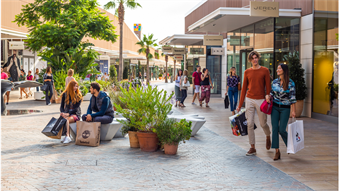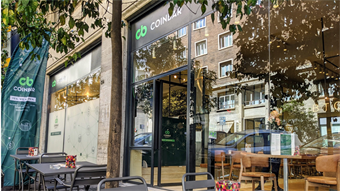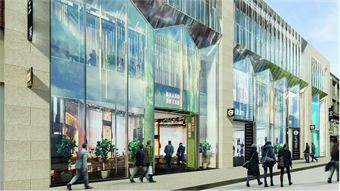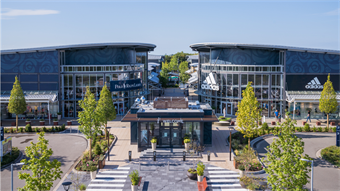Deck the malls
- In Interviews
- 18:05, 17 November 2020
- 3620 Views
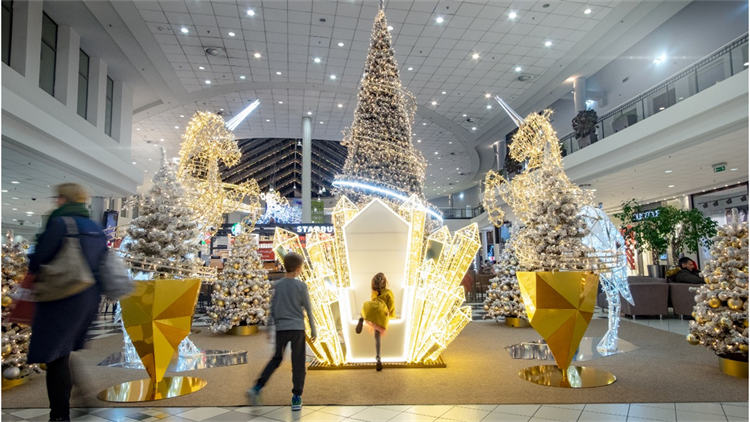
It’s beginning to look a lot like the end of 2020, and the fourth quarter of the solar year has a special place in the hearts of retailers as the traditional time of peak sales.
Yet the economic significance of Christmas for retail real estate landlords has changed significantly over the past decade. Once the true ‘golden quarter’ for high streets, shopping centres and department stores, the ecommerce boom and aggressive Black Friday pricing have altered how consumers prepare for the festive season. Savvy consumers have also long been exchanging cash at Christmas in anticipation of the end of year and January sales.
On top of that, this year, pandemic protocols weigh heavily on retailers and landlords alike, both trying to find the sweet spot between boosting footfall, and avoiding stoking lockdown concerns. It’s a fine line, suggests Liad Barzilai, CEO of Atrium Europe Real Estate, which entered the fourth quarter with 98% of its portfolio operational, except for a handful of retailers in one of its shopping centres in Russia.
‘The Christmas season is very important for the retailers, so it’s important for us.’ Barzilai says. ‘The tricky thing is getting the marketing right, and getting the customers in, while respecting local restrictions and avoiding crowds. On a marketing front, Christmas this year in Atrium’s centres is about ongoing initiatives such as lotteries, rather than single events that bring in 20,000 or 30,000 shoppers on a Saturday. Customers want to shop, and they need to shop: we are trying to help them, with an emphasis on health and safety, to ensure they feel safe.’
Pandemic protocols
In the panorama of European retail landlords, Atrium has fared better than many this year, across its 26 retail-focused assets worth around €2.5 bn, which represent
a gross leasable area of some 808,000 m2. In terms of market value, 85% of its centres are located in cities in Poland and the Czech Republic. In August, sales
reached 93% of the previous year’s level, and footfall was at 77%. Meanwhile, the rent collection rate for the first six months of non-deferred invoices issued reached 91%.
‘The countries where we operate came into this crisis in a relatively good place, with good growth dynamics and fundamentals in Poland and the Cech Republic,’ Barzilai notes. ‘We also had a conservative balance sheet for years. We are continuing with our strategy of divesting non-core shopping centres and expanding into residential.’
Looking forward to 2021, while Atrium has contingency plans in place, the firm hopes to treat 2020 ‘as a one-time event’. Says Barzilai: ‘We think we will come back to a new normal, with more health and safety and some restrictions, but believe we can get back to 2019 numbers and trends. Obviously, a second wave will change that dynamic, but we have also planned for that. If there are further lockdowns in the period before Christmas, we will of course follow the rules. We are remaining in close dialogue with our tenants, as throughout this time.’
High street blues
Unfortunately, the Atrium story isn’t typical across Europe. Many landlords have seen downtown shopping centres and prime high street assets acutely hit by the pandemic, with retail parks, secondary high streets and open-air centres on the whole faring slightly better, according to CBRE. Lining up alongside high-profile landlord casualties such as Intu this year are an increasingly long list of retailers. CVAs, bankruptcies and restructuring moves have affected names from cinema chain Cineworld to Pizza Express, Hays Travel and DW Sports, and even giants such as HSBC. John Lewis group closed eight stores in the summer and expects to make its first ever full-year of losses.
‘Even the West End is suffering,’ notes Jonathan De Mello, equity partner at CWM Retail Consulting, citing a 50-60% fall in footfall this year for some of London’s iconic shopping streets. The picture is not merely one of retail driven online during lockdown procedures, but the ongoing matter of shuttered offices derailing the casual footfall of downtown workers. ‘Retail really needs a good Christmas,’ De Mello says, ‘and the uptick in online trade isn’t always the answer, as delivery comes with a cost.’
He notes that retailers including jewellery, fashion and accessory brands ‘can rely on the golden quarter for up to 50% of their profit’ but this time, are approaching Christmas on the back of an extremely difficult year. ‘Retail turnover has probably dropped by 40% on average, with retailers in the leisure and food and beverages sectors losing as much as 50-60%.’
The winners for De Mello have been local highstreets and retail parks, which have benefitted from customer proximity and practicality. Going into the festive season, independent butchers and local stores may continue to flourish as they meet neighbourhood needs, while ‘retail parks remain attractive for their big box formats, open-air elements and free parking’.
Department store casualties
Professionals in the real estate industry today will probably recall department stores as the custodians of childhood Christmases, with in-house Santas and bespoke decorations drawing the crowds.
The crises and closures of the last five years have changed their centricity in family shopping: some analysts have even called the format a dying breed. ‘In the UK, department store numbers are shrinking by the week,’ notes Mark Phillipson of Eccleston Capital. ‘If their finances weren’t stressed before lockdown, they are now. Even with rent rebates and support from furlough schemes, many retailers are in trouble. They will try and get whatever Christmas trade they can in the bag, and then many people expect there will be another restructuring round in early 2021, as they seek to further offload financial obligations.’
Phillipson is a partner in Quadrant Repurpose, the first single-purpose venture aimed at repurposing redundant department stores and other large retail units across the UK. In the past six months, the outlook for department stores has significantly worsened. ‘Landlords knew that the likes of Debenhams and the House of Fraser weren’t going to pay much rent during this period. But asset managers now have bigger problems on their hands, with retailers across the board asking for turnover leases, rent-free concessions and rent deferments,’ Phillipson notes.
‘At the same time, landlords really don’t want the keys back for department stores right now. They are trying to keep the lights on, with, for example, concession operator 15-17 saving a few property owners, by taking over formats in the UK.’ The asset class is seeing very few freehold trades, Phillipson adds, ‘unless with discounts of around 50% from the quoting price’.
Are there any signs of hope for this market segment? Phillipson thinks there are. ‘Only department stores which are an experience will survive in future,’ he suggests, citing the unique draw of retailers such as Selfridges and Harrods.
‘At the end of the day, a department store is a shopping centre, being full of different brands and concepts. Outlet villages are also just a different approach to the same idea, so there’s no reason why the best department stores will become extinct – if you have the right collection of really interesting retailers, that will always attract people, but they do need to use their surplus physical space more efficiently.
'For all the talk about ecommerce penetration expanding, it’s still only around 30% in the UK. That means that 70% of sales are still taking place in person – but it does illustrate how important an omnichannel approach is. Online sales in supermarkets only increased from 8% to 13% despite the lockdowns – considering the circumstances, you might have imagined that to be much higher.’
Evolving leasing models
One key trend is likely to be further debate around turnover rents, which to date have essentially been confined to the outlet sector. ‘We have just launched a new joint venture called Total Turnover Solutions with outlet centre asset manager Realm, which will help landlords adopt the outlet centre leasing model. The whole retail sector is now crying out for turnover leases. We don’t just supply a software solution but provide the operational model.
When rents are based on sales, the interests of the tenant and the landlord are much more aligned; you’re involved with retailers on a daily basis, analysing turnover and sector performance, and heatmapping sales per square foot. That’s why you tend to get happier tenants in outlet malls – this is undoubtedly the leasing/operating model of the future for shopping centres too,’ Phillipson adds.
Where will growth come in the sector? For Phillipson, the closure of department stores leaves some retailers without a home. ‘What’s going to happen to all the operators of concessions? They still need a physical presence somewhere – apart from supporting their online business, it remains a valid sales channel. Around 50% of online sales take place within a five-mile radius of a physical store. So we are hearing about more enquiries from concessionaires about going back into single units - and this will be a key trend to watch.’
Creating Christmas
In the meantime, the whole sector has to tackle Christmas. ‘The government has a very difficult path to tread. They will be acutely aware of how important Christmas is for
retailers and how much people value the Christmas period as a time of happiness and enjoyment. I think Christmas is more significant than ever this year, and a failure to trade will be the death of many retailers,’ Phillipson warns.
Planning mall activation for the festive season often starts as soon as the previous Christmas is over. For lighting design experts, MK Illumination, a whole year of preparation and planning with shopping centres and cities culminates in a few mad weeks at the end of the year.
Whether you’re decking the malls for Diwali, Christmas, Hanukah, or the Chinese New Year, MK Illumination’s 42 businesses around the world find the fourth quarter tends to be the busiest - even in this, the strangest of years.
‘People spent a lot of time online during the pandemic, but it’s vital that retail shifts offline again this Christmas to avoid disaster,’ suggests Thomas Mark, president of MK Illumination. ‘Centres must find a way to draw shoppers again, and Christmas remains a big lure. We understand that it is very hard to get people back offline when they become accustomed to the ease of online shopping, but creating attractive destinations is half of the battle.’
He adds: ‘Zoom fatigue is real. People got tired of not physically meeting, and more than ever this year, need safe spaces to congregate. Different rules in different territories have made even inviting people into your own home more complicated. Light creates a sense of safety and also has a symbolic value for inspiring hope.
'We use light to transform places, adding mood and atmosphere that fits the season. We need to create experiences in shopping centres that people can’t replicate at home.
‘To experience it, they have to visit the centre. To truly enjoy the experience, they need to meet with family and friends. And to remember it, a photo point can help.’
Cities on board
Memorable Christmas light experiences are also where the partnerships between centres and local authorities come into play. It’s perhaps never been more important that local councils dress squares and streets to support the retail experience this Christmas.
‘One interesting trend is light parks,’ says Mark, ‘which are outdoor attractions created by cities that can bring in visitors from miles around, with an ancillary benefit to retail. This year, their outdoor and spacious nature is more relevant than ever. More generally, well thought-out lights can have a high impact on local tourism. The seaside town of Salerno in southern Italy used to have no winter season. Now, thanks to 27 km of Christmas lights, it attracts 5 million extra visitors in the winter.’
In terms of this year’s trends, tradition and comfort are high on malls’ shopping lists. ‘Many of the lighting displays we are creating this year recall a classic Christmas, with traditional, warm colours and designs, bringing nostalgia and a sense of calm. Photo points are popular for Instagram and postcards; simple installations and concepts can have a greater significance than ever when paired with the right hashtag.
‘Light remains a beacon of our time. Going into Christmas, people really aren’t willing to stay locked in their homes and need attractive spaces that represent an imaginative escape.’ Mark concludes: ‘We know we have to live with the virus, wear masks and pay attention to health protocols, but we need to go forward; and for that, we need to generate hope.’


